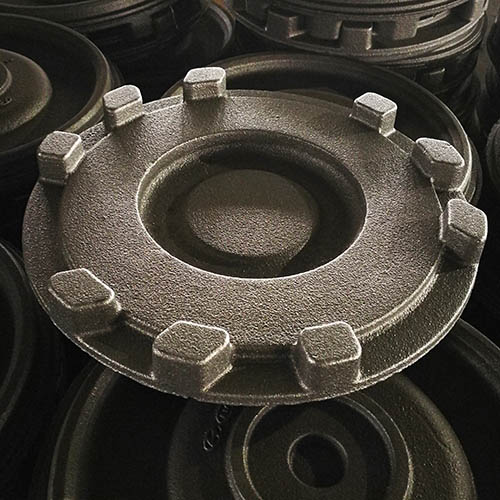Ductile iron parts chemical composition control of large-section cast ferrite
1. Difficulties in the production of large-section ductile iron parts
This type of casting has a large-section and slow cooling, and the metal liquid solidifies for a long time, so shrinkage is easy to occur inside the casting.
When producing ferritic ductile iron, in order to obtain higher tensile strength, yield strength and elongation, ferritization heat treatment is required in the past. The heat treatment temperature is based on whether there is free cementite or pearlite in the cast structure, and a high-temperature heat treatment of 900-950℃ is used. However, the production cost is high, the process is complicated, and the production cycle is long, which brings great difficulties to the production organization and delivery time. This requires that the ferrite matrix must be obtained in the cast state. Therefore, the difficulties in producing this material are mainly the following:
1.1. The casting needs to be inspected by radiography in the specified area, and how to solve the internal shrinkage of the casting;
1.2. How to ensure that more than 90% of the ferrite matrix is obtained in the cast state;
1.3. How to make the material have sufficient tensile strength and yield strength;
1.4. How to obtain sufficient elongation (>18%), and obtain the specified elongation after alloying treatment;
1.5. Use the best alloying treatment process.
2. Control of chemical composition
2.1 Selection of C, Si, and CE
Since spheroidal graphite has little weakening effect on the matrix, the amount of graphite in ductile iron has little effect on the mechanical properties. When the carbon content varies in the range of 3.2% to 3.8%, it has no obvious effect on the mechanical properties. Therefore, when determining the carbon and silicon content in the process, the main consideration is to ensure the casting performance, and the carbon equivalent is selected around the eutectic composition. The molten iron with eutectic composition has the best flowability, a large tendency to form concentrated shrinkage cavities, and a high density of the casting structure. Silicon has a greater effect on increasing ferrite in ductile iron than in gray cast iron, so the silicon content directly affects the amount of ferrite in the ductile iron matrix. Silicon has a great influence on the performance of ductile iron, which is mainly manifested in the solid solution strengthening effect of silicon on the matrix. Silicon can refine graphite and improve the roundness of graphite balls. Therefore, the increase of silicon content in ductile iron can greatly improve the strength index and reduce toughness. The molten iron after spheroidization has a greater tendency to crystallize supercooling and form white cast iron, and silicon can reduce this tendency. However, if the silicon content is too high, the formation of fragmented graphite in large-section ductile iron will be promoted, reducing the mechanical properties of the casting. Data show that the addition of silicon to ductile iron in the form of inoculation can improve the performance to a certain extent.
According to the above analysis, from the perspective of improving casting performance, the carbon equivalent of molten iron is best selected near the eutectic point. At this time, the fluidity of molten iron is the best, the tendency of concentrated shrinkage cavities is greater, and it is easy to compensate for shrinkage. However, too high carbon equivalent will cause graphite floating, and the thickness of the graphite floating layer will thicken with the increase of carbon equivalent. It should be pointed out that too high carbon equivalent is the main reason for graphite floating, but it is not the only reason. Casting size, wall thickness, and pouring temperature are also some important factors.
The relationship between carbon equivalent, casting wall thickness and graphite flotation. Obviously, the carbon equivalent of thin castings can be selected higher, and graphite flotation will not occur. On the contrary, the carbon equivalent of thick and large castings should be selected lower. In short, the upper limit of carbon equivalent is based on the principle of no graphite flotation, and the lower limit is based on no cementite and complete globalization. Under this premise, the carbon equivalent should be increased as much as possible to obtain dense castings.
2.2 Manganese (Mn)
The role of manganese in ductile iron is different from that in gray cast iron. In gray cast iron, manganese can not only strengthen ferrite and stabilize pearlite, but also reduce the harmful effects of sulfur. In ductile iron, spheroidizing elements have a strong desulfurization ability, and manganese no longer has this effect. Because manganese has a serious positive segregation tendency, it is often enriched at the grain boundaries of the eutectic group, which promotes the formation of intergranular carbides and significantly reduces the toughness of ductile iron. For thick and large-section ductile iron, the segregation tendency of manganese is more serious. At the same time, the increase in manganese content increases the pearlite content in the matrix, so while the strength index is improved, the toughness is reduced. The manganese content in high-toughness ductile iron should be more strictly controlled.
Therefore, the lower the Mn, the better if the raw materials are possible. For large castings, the upper limit of manganese control is Mn<0.3%.
2.3 Phosphorus:
Phosphorus has a serious tendency to segregate in ductile iron, and it is easy to form phosphorus eutectics at the grain boundaries, which seriously reduces the toughness of ductile iron. Phosphorus also increases the shrinkage tendency of ductile iron. When ductile iron is required to have high toughness, phosphorus should be controlled below 0.06%.
2.4 Sulfur:
Sulfur in ductile iron has a strong ability to combine with spheroidizing elements to generate sulfides and sulfur oxides, which not only consumes spheroidizing agents and causes unstable spheroidization, but also increases the number of inclusions and accelerates the decay rate of spheroidization. Sulfur in smelting mainly comes from carburizers. While process control reduces the sulfur content in raw materials as much as possible, pre-furnace desulfurization measures are taken.
Before using RE-Mg alloy treatment, the general sulfur residue S <0.02%, which has no effect on spheroidization decay and sulfide slag inclusion. When S>0.02% in the original molten iron, desulfurization treatment must be adopted.
2.5 Molybdenum:
Mo improves the high temperature strength and room temperature strength of the material. Due to the use of Mo, it is easy to form a certain amount of pearlite and carbide, which reduces toughness. For ductile iron with Mo alloying, the material specification requires the Mo content to be controlled at 0.3~0.7%.
2.6 Content of magnesium and rare earth
Magnesium is the main spheroidizing element. Rare earth has desulfurization, neutralizes anti-spheroidizing elements, protects Mg, and improves the anti-decay ability of molten iron. However, rare earth elements are carbide-forming elements, so the residual amount of rare earth should be controlled as much as possible while ensuring good spheroidization. Spheroidization can be guaranteed when Re=0.01~0.04% and Mg=0.03~0.06%. According to the above analysis and calculation, the final chemical composition is as follows: C: 3.3-3.8%; Si: 2.2-2.7%; Mn: <0.30%; S<0.02%; Re=0.01~0.04%; Mg=0.03~0.06%, Mo: 0.3~0.7%





